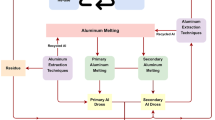Abstract
New techniques that could assist law enforcement officers in the evaluation of radioactive materials of unknown provenance are required. This paper provides preliminary results on a new method for iridium metal dissolution using pressure digestion vessels and hydrogen peroxide, which has been developed for use in forensic applications. The results were generated using iridium powder as a surrogate, but it is anticipated that the method will be directly transferable to iridium source materials.



Similar content being viewed by others
References
IAEA (2004) Strengthening control over radioactive sources in authorized use and regaining control over orphan sources. IAEA-TECDOC-1388
Gil E (2006) Orphaned sources: extending radiological protection outside the regulatory framework, Second European IRPA Congress on Radiation Protection
Trager R (2014) Hunt for stolen radiotherapy unit. Chemistry World 11(2)
British Broadcasting Corporation (2013) Radioactive canister stolen from van in Lancashire. http://www.bbc.co.uk/news/uk-england-lancashire-21497123
IAEA (2007) Nuclear Security Series No. 6: Combating illicit trafficking in nuclear and other radioactive material. STI/PUB/1309
Ferguson CD (2012) Ensuring the security of radioactive sources: national and global responsibilities. US-Korea Institute at SAIS
Leddicotte G (1961) The radiochemistry of iridium. National Academy of Sciences
Rao CRM, Reddi GS (2000) Platinum Group Metals (PGM); occurrence, use and recent trends in their determination. Trends Anal Chem 19(9):565–586
Lee J, Kim Y (2011) Chemical dissolution of iridium powder using alkali fusion followed by high-temperature leaching. Mater Trans 52(11):2067–2070
Balcerzak M (2002) Sample digestion methods for the determination of traces of precious metals by spectrometric techniques. Anal Sci 18:737–750
Styrkas AD, Styrkas D (1995) Electrochemical dissolution of metals of the platinum group by alternating current. J Appl Electrochem 25:490–494
Qi L, Zhou M, Wang CY (2004) Determination of low concentrations of platinum group elements in geological samples by IC-ICP-MS. J Anal At Spectrom 19:1335–1339
Qi L, Zhou M (2008) Determination of platinum-group elements in OPY-1: comparison of results using different digestion techniques. Geostand Geoanal Res 32(3):377–387
Savard D, Barnes S, Meisel T (2010) Comparison between Nickel-Sulfur Fire Assay Te Co-precipitation and isotope dilution with high-pressure asher acid digestion for the determination of platinum-group elements rhenium and gold. Geostand Geoanal Res 34(3):281–291
Ishida K, Hamada T, Morita T (1983) Simple spectrophotometric determination of iridium by oxidation with hydrochloric acid and hydrogen peroxide. Fresenius Z Anal Chem 315:356–357
Ayres GH, Quick Q (1950) Iridium in perchloric, phosphoric, and nitric acid mixtures. Anal Chem 22(11):1403–1408
Rodushkin I, Ruth T, Huhtasaari A (1999) Comparison of two digestion methods for elemental determinations in plant material by ICP techniques. Anal Chim Acta 378:191–200
Fine DA (1970) Studies of the Iridium(III) and (IV)-Chloride system in acid solution. J Inorg Nucl Chem 32:2731–2742
Ezerskaya NA, Kiseleva IN (2001) Coulometric determination of iridium in fluoride and chloride solutions. J Anal Chem 56(9):855–858
Afzaletdinova NG, Murinov YI, Reznik LB, Vasileva EV (2002) Extraction of Iridium(IV) from hydrochloric acid solution with Bis(piperidinoethylthioethyl)-1-phenyl-1-ethanone. Russ J Appl Chem 75(6):900–904
Du Preez JGH, Viviers C, Louw T, Hosten E, Jonck H (2002) The Separation of Rhodium and Iridium. II. Chloridation and chlorination of Iridium(III) and (IV). Russ J Appl Chem 75(6):900–904
Huang YS, Lin SS, Huang CR, Lee MC, Dann TE, Chien FZ (1989) Raman spectrum of IrO2. Solid State Commun 70(5):517–522
Liao PC, Chen CS, Ho WS, Huang YS, Tiong KK (1997) Characterization of IrO2 thin films by Raman spectroscopy. Thin Solid Films 301:7–11
Acknowledgments
The authors would like to thank Dr Imran Khan and Mr Kieran Thorne for the assistance provided during Raman and mass spectrometric analyses, respectively. We are also grateful to AWE plc for the financial support provided to this project.
Author information
Authors and Affiliations
Corresponding author
Rights and permissions
About this article
Cite this article
Hodgson, A.P.J., Jarvis, K.E., Grimes, R.W. et al. Development of an iridium dissolution method for the evaluation of potential radiological device materials. J Radioanal Nucl Chem 307, 2181–2186 (2016). https://doi.org/10.1007/s10967-015-4381-1
Received:
Published:
Issue Date:
DOI: https://doi.org/10.1007/s10967-015-4381-1




